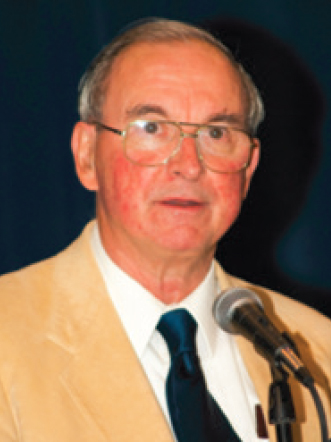
ARTHUR F. VEINOTT JR.
1934–2012
Elected in 1986
“For fundamental contributions to operations research and engineering theory and practice, especially inventory theory and Markovian decision processes.”
ARTHUR FALES VEINOTT JR., a towering figure in the field of operations research, passed away December 12, 2012, at age 78. He was professor of management science and engineering emeritus in the Stanford University School of Engineering, having spent his entire 47-year career there.
Born in Boston on October 12, 1934, and known from childhood as Pete, he spent his early years in Newton and attended public schools there. He obtained his undergraduate education at Lehigh University, earning a BS in industrial engineering and a BA in arts and science in 1956. He was elected to Phi Beta Kappa, Tau Beta Pi, and Omicron Delta Kappa. He went on to Columbia University where, in 1960, he earned a PhD in industrial engineering with specialization in operations research; his thesis supervisor was Cyrus Derman, with whom he maintained a lifelong friendship.
After receiving his doctorate, Pete became a 1st lieutenant in the US Air Force, serving as an operations analyst in the Operations Analysis Office of the Air Force Logistics Command.
After 2 years in this capacity he joined the Stanford faculty as an assistant professor in the Department of Industrial Engineering. He was promoted to associate professor in 1964 and full professor in 1967, at which time the Department of Operations Research (OR) was launched, after being a program
for 5 years. He chaired the OR Department for 10 years (1975–85). In addition, in 1975 he and several other Stanford faculty members created and taught in the highly successful undergraduate Program in Mathematical and Computational Science.
Along with Kenneth Arrow, Gerald Lieberman, and others, Pete did much to build Stanford’s OR doctoral program into one of world-renowned importance. In the process, he augmented his already extensive knowledge of mathematics, statistics, economics, and computer science, disciplines that play leading roles in OR. He was arguably a master of the entire contemporary OR field, making significant contributions to special topics such as inventory theory, supply chain management, dynamic programming, and lattice programming, all of which were deepened and broadened by his comprehensive scholarship.
From 2001 to 2004 Pete was also a principal investigator and codirector of the General Motors/Stanford Collaborative Research Laboratory in Work Systems, an initiative that exemplifies how industrial issues and academic interests can be brought together to address problems of practical importance.
A unifying theme of his research and that of his many students was to find and elucidate structure in the optimal solutions of complex optimization problems. The relentless pursuit of this goal was one of his characteristic traits. Pete was demanding of himself and of his 28 thesis advisees; his exacting standard meant that he was never content to rush the submission of a manuscript for publication.
Pete’s primary professional affiliation was with the Institute for Operations Research and the Management Sciences (INFORMS), created in 1995 from the merger of the Operations Research Society of America (ORSA) and the Institute of Management Sciences (TIMS). He is especially noted for two major initiatives: his conception and service as founding (later, advisory) editor of Mathematics of Operations Research (1974–80) and his work in bringing about the annual John von Neumann Theory Prize, first awarded in 1975 to an individual or group who has made fundamental and sustained contributions to theory in operations research and the management sciences.
Elected to the National Academy of Engineering in 1986, Pete received the von Neumann Theory Prize in 2007 “for his profound contributions to three major areas of operations research and management science: inventory theory, dynamic programming, and lattice programming.” He became a fellow of the Institute of Mathematical Statistics in 1970 and of INFORMS in 2002. He was also a Guggenheim Fellow (1978–79).
Pete’s passion for learning went beyond his academic life. A self-taught avid tennis player, self-educated early adopter of new technologies, and well read in history, he always enjoyed sharing ideas with family and friends. It was not uncommon for the Encyclopedia Britannica (later replaced by Google) to make an appearance at the dinner table to settle differences of opinion.
Pete was dedicated to moving forward in his pursuits and not being held back by requirements he felt were unnecessary. He demonstrated this early on when he became an Eagle Scout at age 14, having negotiated in advance with his troop leaders that his age should not be an impediment to becoming an Eagle Scout if all other requirements were met. This was a defining trait that he applied throughout his personal and professional life: every challenge worth pursuing was met with complete dedication and determination.
He enjoyed sailing, bird watching, and reading and he loved life. He often said of Stanford “we live in paradise.” He was proud of his wife and children, and had a soft spot for his young grandchildren.
In June 2009, faced with a serious medical condition, Pete Veinott joined the ranks of the faculty emeriti. With grace and composure, he continued his engagement with academic and scientific activities to the very end. He is survived by his wife Adriana Diener-Veinott (Stanford, CA), daughter Beth Veinott (Shane) (Houghton, MI), son Mike Veinott (Susan) (San Jose, CA), and two grandchildren.




